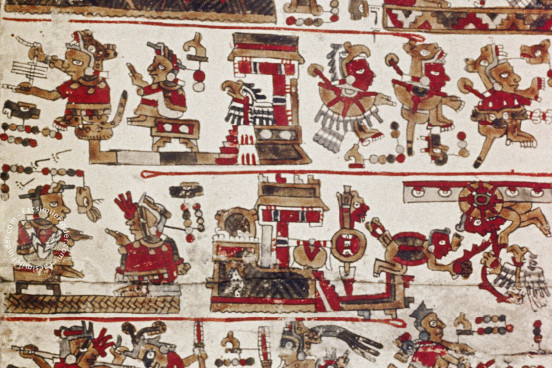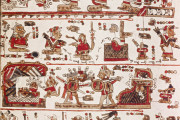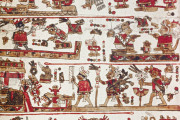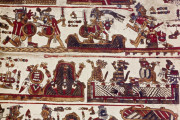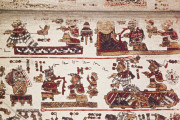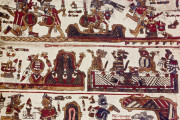The Codex Selden is a pictographic screenfold relating the dynastic history of the rulers of Jaltepec from its legendary beginnings (ca. 780) until 1556. Created in the Mixteca region of New Spain in 1556 or shortly thereafter by one or more indigenous painter-scribes, it is one of an important group of genealogical screenfolds that includes the Codex Yuta Tnoho, the Codex Zouche-Nuttall, and the Codex Waecker-Götter. Together, their complementary and overlapping content tells the history of the pre-Columbian Mexican city-states. Selden includes an extensive account of the life of Lady Six Monkey (eleventh century), a key figure in Jaltepec's history. The current manuscript has painting only on the obverse, which extends across twenty panels.
Although the manuscript was created a generation or more after the Spanish arrival in Mexico, the paintings relate the story of the ruling dynasty of Jaltepec in the traditional pre-Columbian visual vocabulary of pictographs. There are many images of the protagonists, their names given in phonetic glyphs, with place names and dates also indicated by glyphs.
Traditional Format
Despite its nickname, the Codex Selden is not a book sewn at the spine with pages that can be turned. It is rather a screenfold, a book folded accordion style. The content of the Codex Selden is presented over the length of the document from bottom to top, starting at the lower right and continuing in a boustrophedon pattern (right-to-left then left-to-right zig-zag) up to the top. Thin horizontal red lines divide the registers and guide the reader's course.
Traditional Technique and Palette
The manuscript was fashioned of four strips of deerskin pasted or glued together end-to-end to create one long strip. The surface was covered with a thin layer of plaster to receive the paint. The pictographs are painted, for the most part, with bold black outlines and in a palette dominated by red and ocher, supplemented by olive green, brown, and gray. Journeys are indicated by stylized footprints in black.
A Trip through Time
The Codex Selden, as is characteristic of the Mixtec genealogies, presents the passing of historical time with remarkable elasticity. Its content is event-driven, with a focus on ceremonies and intricate kinships and alliances, which means that time "slows" at certain points to include more detail when demanded by the density of information. The date glyphs help the reader to keep track of the passage of time in the unfolding of local history.
A Mystery beneath the Plaster
The Codex Selden is a palimpsest, i.e., a manuscript of two texts, the one that can now be read on the surface and one that has been effaced. The first fifteen panels of the manuscript were originally painted on both sides. That content has been, in the words of an early observer, "scrubbed out," with new plaster applied on top. To that was added more deerskin to accommodate the present text of twenty panels on one side of the screenfold.
An Early Addition to the Bodleian Library
The manuscript is named for its first known owner, the English legal scholar John Selden (1584-1654). He bequeathed his extensive library—which included the Selden Roll and the Codex Mendoza, also manuscripts relating to precolonial Mexican history—to the Bodleian Library, which first opened to scholars in 1602.
We have 1 facsimile edition of the manuscript "Codex Selden": Codex Selden 3135 (A. 2) facsimile edition, published by Sociedad Mexicana de Antropología, 1964
Request Info / Price
